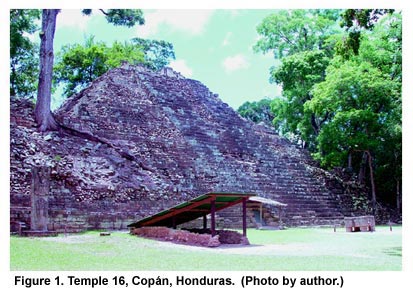
| FAMSI © 2004: Jorge Ramos |
||
|
Research on Temple 16: An Ongoing Imagery Reconstruction of Temple 16, Copán, Honduras Introduction The discovery that each building and its elaborate façade conveyed a particular visual message was a step forward in understanding the Copán Polity. This observation has also led to the development of new methodologies and approaches for the study of the Maya at Copán (B. Fash and W. Fash 1992). It was discovered long ago that the rulers’ purpose behind the erection and dedication of monumental temple platforms with their ornamental giant masks and their magnificent carved stone monoliths was the achievement of ideological and political power (Schele and Miller 1986:34; Schele and Mathews 1998:30; Webster 1988:24). It is also clear that Maya rulers used monumental art as a means to manipulate symbols to create and maintain power positions (Webster 1988:23). Political symbols and particular rituals under different cultural expressions are able to construct social meanings that will shape the reality in which people live (Geertz 1974). Regardless of the mechanisms by which members of the elite are chosen in complex societies, such people seek to justify their existence through a variety of symbolic forms (Geertz 1974:124). At Copán, Yax Pasah, the 16th ruler, constructed what is known today as Temple 16 (Structure 10L-16) at the apex of the Acropolis. While today this temple is largely gone (Figure 1), careful analysis of its components has provided extensive information on the manner in which it was used to support the rulership of its creator. The preliminary study of some of the sculpture panels that formerly decorated the temple façades is indicative of the role ancestors and history (or social memory) played during Yax Pasaj’s reign (A.D. 762-820). These were instrumental cultural means for this ruler in his efforts to maintain his power in a time of political, ideological, and economic decadence. |
||
|
Text links to all pages at this site are available at the FAMSI INDEX |
||
